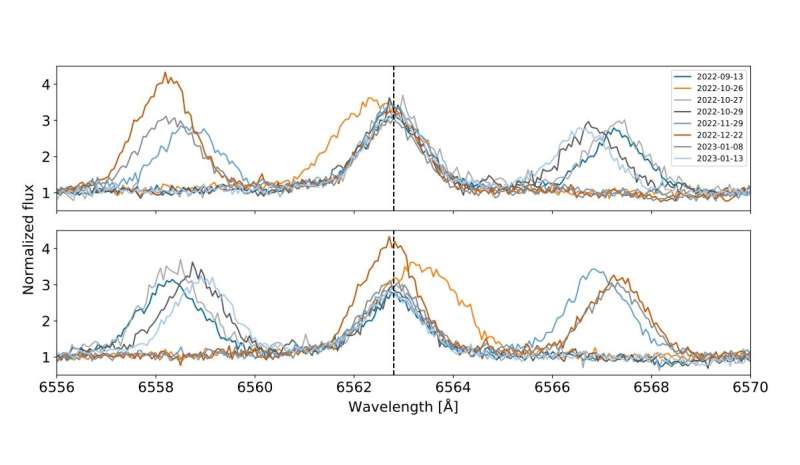April 12, 2023 report
This article has been reviewed according to Science X's editorial process and policies. Editors have highlighted the following attributes while ensuring the content's credibility:
fact-checked
preprint
trusted source
proofread
G 68-34 is an M-dwarf eclipsing binary, observations find

Using the Tillinghast Reflector Echelle Spectrograph (TRES) and the Transiting Exoplanet Survey Satellite (TESS), astronomers from the Harvard-Smithsonian Center for Astrophysics (CfA) have detected an M-dwarf companion to a nearby M-dwarf star designated G 68-34. The finding, published April 5 on the pre-print server arXiv, identifies G 68-34 a double-lined M-dwarf eclipsing binary.
Detached, double-lined, eclipsing spectroscopic binaries (DLEBs) are crucial for astronomers testing stellar models. This is due to the fact that the masses and radii of both stars can be directly measured from the light and radial velocity curves of the system.
At a distance of some 127 light years from the Earth, G 68-34 is a nearby M dwarf, forming a widely separated (by 9 arcseconds) binary with a white dwarf known as LP 463-28. Previous observations of this white dwarf-M dwarf pair have found that G 68-34 rotates with a period of 0.655 days, and that the system is older than five billion years based on the white-dwarf cooling age.
Given that G 68-34 has an anomalously rapid rotation, CfA's Emily K. Pass and David Charbonneau suppose that G 68-34 may be a close binary. They have recently obtained high-resolution spectra with TRES and photometry from TESS in order to verify this hypothesis.
"We observed G 68-34 with the TRES spectrograph on the 1.5m telescope at the Fred Lawrence Whipple Observatory (FLWO). We observed the star at eight epochs between September 2022 September and January 2023, with exposure times varying between 2,160 and 3,600 seconds depending on sky conditions. ... G 68-34 was observed at 2-minute cadence by TESS in its sector 56, which occurred in September 2022," the researchers wrote.
The observations first confirmed that G 68-34 is indeed a double-lined spectroscopic binary. Furthermore, photometry from TESS revealed that the pair also eclipses, which makes it a double-lined eclipsing binary.
By analyzing the collected data, it was found that G 68-34 is composed of two M dwarfs. The primary and secondary stars have radii of 0.345 and 0.342 solar radii, while their masses are 0.328 and 0.32 solar masses, respectively. The astronomers noted that G 68-34 is therefore a nearly equal-mass M-dwarf binary, with both components likely being fully convective.
The age of the G 68-34 binary is yet to be determined. However, given that its widely separated white-dwarf primary LP 463-28 has a cooling age of five billion years, G 68-34 must be at least this old. The researchers added that it is necessary to find out how long LP 463-28 was on the main sequence in order to calculate the total age of G 68-34.
Summing up the results, the authors of the paper estimate that the total age of G 68-34 is about 6.7 billion years. They concluded that galactic kinematics of this system suggests that it is part of the Galactic disk.
More information: Emily K Pass et al, G 68-34: A Double-Lined M-Dwarf Eclipsing Binary in a Hierarchical Triple System, arXiv (2023). DOI: 10.48550/arxiv.2304.02466
Journal information: arXiv
© 2023 Science X Network





















